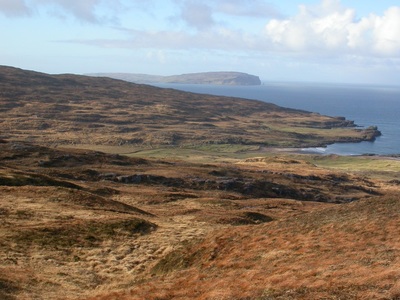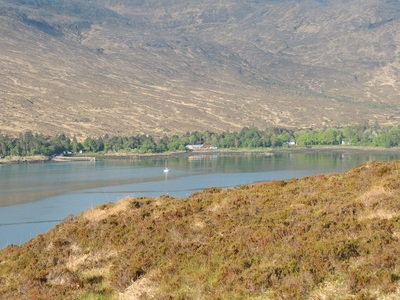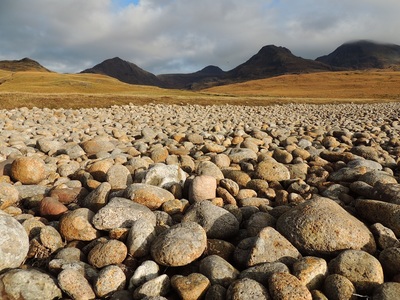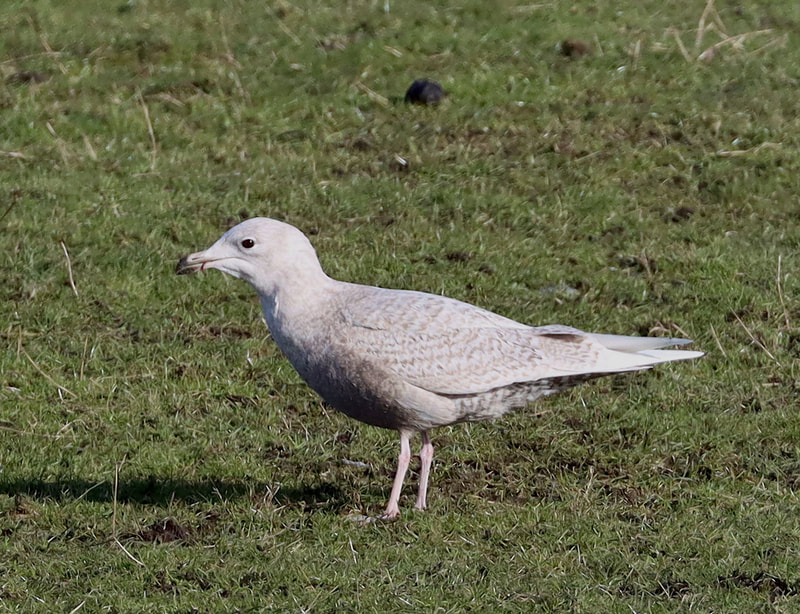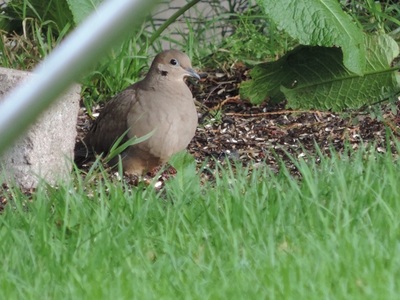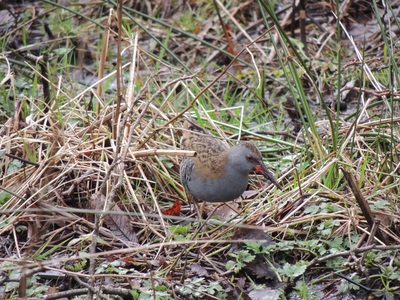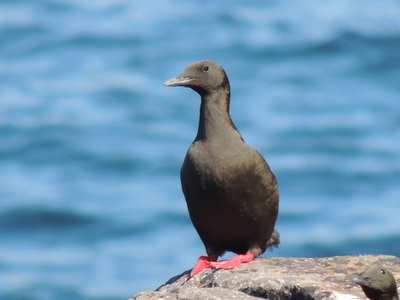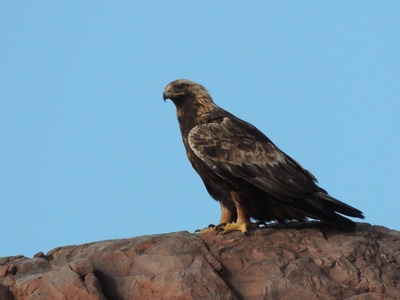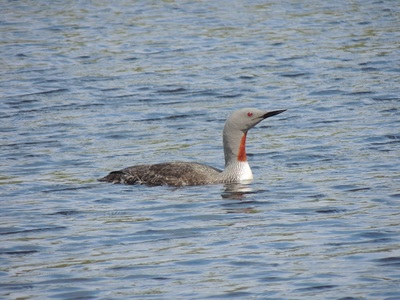Birding on Rum (Written by Sean Morris)
Introduction
Rum is the largest of the Small Isles located just over 15 miles west of Mallaig on the west coast of Scotland. The majority of the 10,684 hectares of Rum is managed as a National Nature Reserve by NatureScot with a small area in and around the village of Kinloch owned and managed by the Isle of Rum Community Trust.
Rum is a rugged and mountainous island formed by the eruption of a volcano 60 million years ago and since shaped by the actions of glaciers. Habitats range from high mountain tops and boggy moorlands to richer lowland grasslands in some of the glens. Much of the coastline is rocky with precipitous cliffs. Sheltered bays are few and far between with only two sandy beaches in the north of the island and the more mud-based harbour of Loch Scresort in the east. Trees are relatively scarce on Rum and the only remnants of natural woodland are found in steep-sided gullies and cliffs. There are mature woodlands in Kinloch and at Papadil which contain a mixture of native and exotic species and were planted before the island became a nature reserve. Since 1957 there have been major efforts at woodland restoration particularly around Kinloch and the east of Rum. There are also some small experimental tree plots in Kilmory Glen, Harris and Guirdil.
Rum is the largest of the Small Isles located just over 15 miles west of Mallaig on the west coast of Scotland. The majority of the 10,684 hectares of Rum is managed as a National Nature Reserve by NatureScot with a small area in and around the village of Kinloch owned and managed by the Isle of Rum Community Trust.
Rum is a rugged and mountainous island formed by the eruption of a volcano 60 million years ago and since shaped by the actions of glaciers. Habitats range from high mountain tops and boggy moorlands to richer lowland grasslands in some of the glens. Much of the coastline is rocky with precipitous cliffs. Sheltered bays are few and far between with only two sandy beaches in the north of the island and the more mud-based harbour of Loch Scresort in the east. Trees are relatively scarce on Rum and the only remnants of natural woodland are found in steep-sided gullies and cliffs. There are mature woodlands in Kinloch and at Papadil which contain a mixture of native and exotic species and were planted before the island became a nature reserve. Since 1957 there have been major efforts at woodland restoration particularly around Kinloch and the east of Rum. There are also some small experimental tree plots in Kilmory Glen, Harris and Guirdil.
most daysGetting to Rum
Rum can be reached most days in the summer either by Caledonian MacBrayne ferry from Mallaig or various charter boats from the mainland and Skye. MV Sheerwater also sometimes runs trips to Rum during the summer from Arisaig.. Travel in the winter is more restricted with the ferry from Mallaig the only option. Vehicles are not allowed on Rum but the recently upgraded tracks to Harris and Kilmory are suitable for mountain bikes.
Places to Stay
There are a number of options including a guest house, cabins and camping.
Birds and Birding Locations
Before you even arrive on Rum it’s worth keeping an eye out on the ferry journey for any interesting birds. In the late summer months Manx Shearwaters are a common sight from the ferry and thousands can sometimes be observed on the journey across. Other seabirds are also common including Gannet, Kittiwake, auks and Shag. Great Skuas now breed on several of the Small Isles and can sometimes be observed from the ferry. Scarcer seabirds are also sometimes spotted and sightings of Arctic and Pomarine Skuas, Sooty Shearwater and Storm Petrel are also possible.
Rum can be reached most days in the summer either by Caledonian MacBrayne ferry from Mallaig or various charter boats from the mainland and Skye. MV Sheerwater also sometimes runs trips to Rum during the summer from Arisaig.. Travel in the winter is more restricted with the ferry from Mallaig the only option. Vehicles are not allowed on Rum but the recently upgraded tracks to Harris and Kilmory are suitable for mountain bikes.
Places to Stay
There are a number of options including a guest house, cabins and camping.
Birds and Birding Locations
Before you even arrive on Rum it’s worth keeping an eye out on the ferry journey for any interesting birds. In the late summer months Manx Shearwaters are a common sight from the ferry and thousands can sometimes be observed on the journey across. Other seabirds are also common including Gannet, Kittiwake, auks and Shag. Great Skuas now breed on several of the Small Isles and can sometimes be observed from the ferry. Scarcer seabirds are also sometimes spotted and sightings of Arctic and Pomarine Skuas, Sooty Shearwater and Storm Petrel are also possible.
n occasionalKinloch and Loch Scresort
Kinloch in the east of the island is where the ferry terminal is located and is the most accessible site for bird watchers on a day trip. Loch Scresort is a sheltered bay and is worth scanning for wildfowl and waders. Red-throated Divers are common in summer but are mostly replaced by Great Northern Divers during the winter. A sizeable flock of Eiders is present in the spring and the males can be heard displaying. Good views can also be obtained of Red-breasted Merganser and Black Guillemot. There is a resident flock of Greylag Geese and Brent Geese and Whooper Swans are sometimes forced down by stormy weather while on migration.
Oystercatcher and Curlew are the commonest waders both in summer and winter. One or two Redshank are present in the winter with occasional larger flocks of migrants in the spring and autumn. Greenshank is a rare breeder on Rum but off duty birds can be seen on the shore of Loch Scresort on most days in the early spring and summer. Common Sandpiper is relatively common in summer and Woodcock and Snipe can be heard displaying over the woodland and crofts too.
Water Rail is an occasinal winter visitor and can be heard and sometimes seen in marshy areas.
Herring, Common and Great Black-backed Gulls are common all year round while Lesser Black-backed Gulls can be observed in the summer. Black-headed gulls are regular on passage and both Glaucous and Iceland Gulls can sometimes be seen in winter.
Kinloch is the best location on Rum to observe woodland birds. Resident species of finch and thrush are common including Chaffinch, Blackbird and Song Thrush. Smaller residents include Blue, Great and Coal Tits, Long-tailed Tit, Goldcrest, Treecreeper, Robin, Wren and Dunnock. Resident species are joined by migrants in the summer with Willow Warbler being by far the commonest warbler in the Kinloch woodlands. Other warblers that can be seen or heard include Chiffchaff, Blackcap, Sedge Warbler and Whitethroat. Unfortunately Wood Warbler seems to have been lost as a regular breeding species on Rum. Swallows can be seen in summer and breed in some of the old buildings around Kinloch.
In the spring and autumn many migrants can be seen with impressive numbers of Redwings and lesser numbers of Fieldfares passing through and Brambling is also a regular autumn visitor.
Kinloch has turned up an impressive list of scarce and rare birds in recent years with Mourning Dove, Bittern, Hoopoe, Common Rosefinch, Rose-coloured Starling and Hawfinch all being observed.
Kinloch in the east of the island is where the ferry terminal is located and is the most accessible site for bird watchers on a day trip. Loch Scresort is a sheltered bay and is worth scanning for wildfowl and waders. Red-throated Divers are common in summer but are mostly replaced by Great Northern Divers during the winter. A sizeable flock of Eiders is present in the spring and the males can be heard displaying. Good views can also be obtained of Red-breasted Merganser and Black Guillemot. There is a resident flock of Greylag Geese and Brent Geese and Whooper Swans are sometimes forced down by stormy weather while on migration.
Oystercatcher and Curlew are the commonest waders both in summer and winter. One or two Redshank are present in the winter with occasional larger flocks of migrants in the spring and autumn. Greenshank is a rare breeder on Rum but off duty birds can be seen on the shore of Loch Scresort on most days in the early spring and summer. Common Sandpiper is relatively common in summer and Woodcock and Snipe can be heard displaying over the woodland and crofts too.
Water Rail is an occasinal winter visitor and can be heard and sometimes seen in marshy areas.
Herring, Common and Great Black-backed Gulls are common all year round while Lesser Black-backed Gulls can be observed in the summer. Black-headed gulls are regular on passage and both Glaucous and Iceland Gulls can sometimes be seen in winter.
Kinloch is the best location on Rum to observe woodland birds. Resident species of finch and thrush are common including Chaffinch, Blackbird and Song Thrush. Smaller residents include Blue, Great and Coal Tits, Long-tailed Tit, Goldcrest, Treecreeper, Robin, Wren and Dunnock. Resident species are joined by migrants in the summer with Willow Warbler being by far the commonest warbler in the Kinloch woodlands. Other warblers that can be seen or heard include Chiffchaff, Blackcap, Sedge Warbler and Whitethroat. Unfortunately Wood Warbler seems to have been lost as a regular breeding species on Rum. Swallows can be seen in summer and breed in some of the old buildings around Kinloch.
In the spring and autumn many migrants can be seen with impressive numbers of Redwings and lesser numbers of Fieldfares passing through and Brambling is also a regular autumn visitor.
Kinloch has turned up an impressive list of scarce and rare birds in recent years with Mourning Dove, Bittern, Hoopoe, Common Rosefinch, Rose-coloured Starling and Hawfinch all being observed.
Kilmory
Kilmory is situated on the north coast of Rum about 5 miles from Kinloch. Access is along a reasonable quality track and takes about an hour and 30 minutes to walk or cycling is also an option. The track from Kinloch passes over open moorland through Kinloch Glen and it is worth scanning the ridges and skyline for Golden Eagles and Ravens which can often be seen. Other raptor species that may be seen here are hunting Merlins and Hen Harriers. Meadow Pipit is very common in summer and Stonechats also breed along the track sides. The track splits in the middle of the island and the right hand fork heads down Kilmory Glen to Kilmory. Several small tree plots are passed in Kilmory Glen and these are worth scanning for the usual array of woodland birds already mentioned, although numbers are lower and some species present in Kinloch are absent from these woodlands. These tree plots can occasionally attract scarcer migrants in spring and autumn with Common Crossbill, Waxwing, Red-backed Shrike and Yellow-browed Warbler all being seen in recent years.
Oystercatcher and Curlew both breed at Kilmory and Golden Plover are also a common sight on the short grass. Kilmory is one of the few locations on Rum where Ringed Plover can be seen and a few pairs breed on the beach. Kilmory is probably the best location on Rum to observe migrant waders and Dunlin, Redshank, Greenshank, Turnstone and Sanderling are regular in late summer and autumn. Rare and scarce waders for Rum spotted at Kilmory in recent years include Grey Plover, Ruff, Purple Sandpiper and Buff-breasted Sandpiper.
Most of the seabirds and gulls already mentioned can also be seen from Kilmory. Vagrant gulls seen at Kilmory include Mediterranean gull in November 2014. Arctic and common terns occasionally breed at Kilmory in varying numbers.
Wheatear and Skylark can be regularly seen at Kilmory and Cuckoo is common in spring. Twite are a scarce breeder but larger flocks can be observed in the autumn and Snow Buntings can sometimes be seen in the winter. Vagrant passerines to Kilmory have also included Black Redstart, Ovenbird and Richard's Pipit.
Geese are regular migrants overhead including Pink-footed and Barnacle and also Whooper Swans but they rarely if ever land.
Kilmory is situated on the north coast of Rum about 5 miles from Kinloch. Access is along a reasonable quality track and takes about an hour and 30 minutes to walk or cycling is also an option. The track from Kinloch passes over open moorland through Kinloch Glen and it is worth scanning the ridges and skyline for Golden Eagles and Ravens which can often be seen. Other raptor species that may be seen here are hunting Merlins and Hen Harriers. Meadow Pipit is very common in summer and Stonechats also breed along the track sides. The track splits in the middle of the island and the right hand fork heads down Kilmory Glen to Kilmory. Several small tree plots are passed in Kilmory Glen and these are worth scanning for the usual array of woodland birds already mentioned, although numbers are lower and some species present in Kinloch are absent from these woodlands. These tree plots can occasionally attract scarcer migrants in spring and autumn with Common Crossbill, Waxwing, Red-backed Shrike and Yellow-browed Warbler all being seen in recent years.
Oystercatcher and Curlew both breed at Kilmory and Golden Plover are also a common sight on the short grass. Kilmory is one of the few locations on Rum where Ringed Plover can be seen and a few pairs breed on the beach. Kilmory is probably the best location on Rum to observe migrant waders and Dunlin, Redshank, Greenshank, Turnstone and Sanderling are regular in late summer and autumn. Rare and scarce waders for Rum spotted at Kilmory in recent years include Grey Plover, Ruff, Purple Sandpiper and Buff-breasted Sandpiper.
Most of the seabirds and gulls already mentioned can also be seen from Kilmory. Vagrant gulls seen at Kilmory include Mediterranean gull in November 2014. Arctic and common terns occasionally breed at Kilmory in varying numbers.
Wheatear and Skylark can be regularly seen at Kilmory and Cuckoo is common in spring. Twite are a scarce breeder but larger flocks can be observed in the autumn and Snow Buntings can sometimes be seen in the winter. Vagrant passerines to Kilmory have also included Black Redstart, Ovenbird and Richard's Pipit.
Geese are regular migrants overhead including Pink-footed and Barnacle and also Whooper Swans but they rarely if ever land.
Rum Cuillin and the Manx Shearwater Colony
No birding trip to Rum would be complete without a night time trip up to the Manx Shearwater colony in the high mountains of the Rum Cuillin. However, this is a serious undertaking and should only be attempted by experienced hill walkers with suitable equipment and experience of mountain navigation in the mist and dark. NatureScot may offer occasional guided walks into the colony for those not confident to do it themselves. The north facing slopes of Hallival are probably the easiest parts of the colony to reach but beware the slopes are very steep and care should be taken. It’s best to walk up in the evening in daylight and find a comfortable place to sit and wait until dark. The birds only start to come into the colony well after dusk but the sound of thousands of calling shearwaters all around is a truly amazing spectacle. The birds are easily disorientated by bright lights so it is best not to use powerful torches.
No birding trip to Rum would be complete without a night time trip up to the Manx Shearwater colony in the high mountains of the Rum Cuillin. However, this is a serious undertaking and should only be attempted by experienced hill walkers with suitable equipment and experience of mountain navigation in the mist and dark. NatureScot may offer occasional guided walks into the colony for those not confident to do it themselves. The north facing slopes of Hallival are probably the easiest parts of the colony to reach but beware the slopes are very steep and care should be taken. It’s best to walk up in the evening in daylight and find a comfortable place to sit and wait until dark. The birds only start to come into the colony well after dusk but the sound of thousands of calling shearwaters all around is a truly amazing spectacle. The birds are easily disorientated by bright lights so it is best not to use powerful torches.
